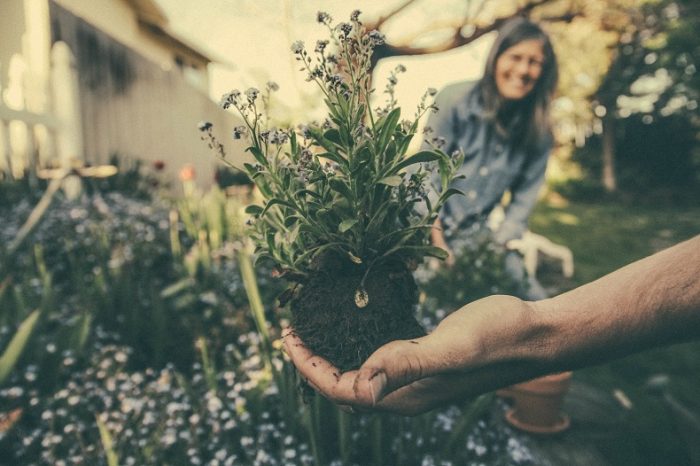“Many things grow in the garden that were never sown there.” ~ Thomas Fuller
~
For those of us toiling away, year after blessed year, planting, replanting, moving, organizing, and simply watching our gardens grow, there is no summit—no final result, no end game, and no resting upon any lovely, proverbial laurels.
For most of us, gardening is a limitless journey, gloriously triumphant indeed, but also filled to the brim with the pitfalls of small, crushing disappointments. A garden will come to fruition only to make way for a whole new journey of transformation over and over again. We are never truly satisfied—and if we are, it’s surprisingly delightful, but quite short-lived.
Doesn’t that sound great?
By experiencing the joy and the pain (the sunshine and the rain) of cultivating my garden, I’ve learned the answers to more questions than I ever thought to ask. The Thomas Fuller quote above is fitting, because it gets to the heart of why gardening is so rewarding. The trials, tribulations, achievements, and expectations of any avid gardener run parallel to some of the more poignant “life lesson” metaphors we all experience.
The wisdom gleaned from our garden is worth all the work we put into it.
Consistent “tending” is the most important part. A garden either dies quickly or grows unruly without attention, and the same can be said about the other things we “tend” in our lives (children, loved ones, friends, pets, and homes). All we claim to love, great or small, requires our ever vigilant care.
The slug and bug battles never cease in a garden, and they never will in life. We will always have obstacles to overcome and stinging wrenches thrown into the mix, just to make things interesting. These hardships, though, are what make us resilient. Growing up and around the weeds and the pests is how we survive and thrive. When we come back stronger, year after year, defying setbacks and “bad conditions,” and when we rise like the hardy perennials we sow, we learn that hope is the thing that fights. There’s always a way, as long as we have the will.
But there are some battles not worth fighting. Black-eyed Susan and honeysuckle taught me that some things can’t be contained or harnessed into submission. I learned to save my happy energy and simply stop fighting a battle I couldn’t win. These plants, like certain people and situations in my life, do what they want to do, despite my direction, objection, or my correction. The only way to deal with them is to let them be.
Gardening teaches an honest day’s work. It’s blood, sweat, and tears that yield sore muscles and fatigue like no other physical activity (other than labor and delivery of a child). I’ve done both, so I can compare. After a day spent in my garden, I fall into bed exhausted—but it’s a good and glorious exhaustion, an accomplished exhaustion that offers the endless reward of sore muscles the following day too! I joke a bit, but tending a garden is like boot camp with a whole bunch of yoga mixed in. It’s the perfect workout for every last inch of my body.
And we learn to be patient. A garden is never “finished,” so patience is always required. We wait months, years even, to see if our “brilliant ideas” are actually working. If planting bulbs in the fall—only to weather a horribly long and cold winter waiting for them to poke through the soil—doesn’t teach patience (and the joys of anticipation), I’m not sure what will. Instant gratification is occasional with gardening (nothing beats a fresh mulch job), but it’s not exactly highlighted in the plus column. Garden goals take time. They are an ever evolving endeavor, and seeing our ideas take shape requires a bit of curious hope, mixed with diligent perseverance.
It will guide us to curate and edit. By allowing our plants to do the talking, we can discern what’s good, bad, ugly, or not thriving. They will always let us know where they’re perfectly happy, where they’re miserable, where they don’t belong, and why they will do better elsewhere. This is very much like life itself. We can sift through the experiences, people, and things that either feed or deprive our souls, in order to get the most reward in the short time and space we occupy earth.
We realize that change is often necessary for growth. We all like our comfortable little place in the world, even if we’re stagnant (too damp, not quite enough sun), but that can sometimes keep us from our own potential. Upheaval, necessary separation, or moving to a new location is often the catalyst for bigger, brighter blooms in a garden, as well as higher enlightenment in the journey of our lives.
The garden releases an artist within. It nudges us to create—and creation in any way, shape, or form is nectar for happiness, motivation, and vitality. It allows us to be imaginative, whimsical, and resourceful all at the same time. From inception, to design, to installation, to simply watching our vision grow, a garden feeds our need to express ourselves. It teaches us to share our unique view and our personalities—because just like people, no two gardens are exactly the same.
Gardeners are inspired by the mindful interchange of peace and respect. We experience peace within the tranquility of the surroundings we develop, especially when we respect the difficult work it takes to get there. Gardening provides an opportunity to cultivate beauty, if only for the sake of the shear, satisfying pleasure it brings. When we concede to the value and enjoyment of the journey instead of its concluding view, we have learned all we really need to know about life. Our gardens are a few yards of growing hope, ever changing parcels of infinite, bursting miracles that teach us, by merely living, how to be alive.
~
 Share on bsky
Share on bsky






Read 1 comment and reply